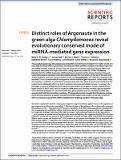Por favor, use este identificador para citar o enlazar a este item:
http://hdl.handle.net/10261/240228COMPARTIR / EXPORTAR:
 SHARE SHARE
 CORE
BASE CORE
BASE
|
|
| Visualizar otros formatos: MARC | Dublin Core | RDF | ORE | MODS | METS | DIDL | DATACITE | |

| Título: | Distinct roles of Argonaute in the green alga Chlamydomonas reveal evolutionary conserved mode of miRNA-mediated gene expression |
Autor: | Chung, Betty Y. W.; Valli, Adrián; Deery, Michael J.; Navarro, Francisco J.; Brown, Katherine; Hnatova, Silvia; Howard, Julie; Molnar, Attila; Baulcombe, David C. | Palabras clave: | Evolution miRNAs |
Fecha de publicación: | 2019 | Editor: | Springer Nature | Citación: | Scientific Reports 9: 11091 (2019) | Resumen: | The unicellular green alga Chlamydomonas reinhardtii is evolutionarily divergent from higher plants, but has a fully functional silencing machinery including microRNA (miRNA)-mediated translation repression and mRNA turnover. However, distinct from the metazoan machinery, repression of gene expression is primarily associated with target sites within coding sequences instead of 3′UTRs. This feature indicates that the miRNA-Argonaute (AGO) machinery is ancient and the primary function is for post transcriptional gene repression and intermediate between the mechanisms in the rest of the plant and animal kingdoms. Here, we characterize AGO2 and 3 in Chlamydomonas, and show that cytoplasmically enriched Cr-AGO3 is responsible for endogenous miRNA-mediated gene repression. Under steady state, mid-log phase conditions, Cr-AGO3 binds predominantly miR-C89, which we previously identified as the predominant miRNA with effects on both translation repression and mRNA turnover. In contrast, the paralogue Cr-AGO2 is nuclear enriched and exclusively binds to 21-nt siRNAs. Further analysis of the highly similar Cr-AGO2 and Cr-AGO 3 sequences (90% amino acid identity) revealed a glycine-arginine rich N-terminal extension of ~100 amino acids that, given previous work on unicellular protists, may associate AGO with the translation machinery. Phylogenetic analysis revealed that this glycine-arginine rich N-terminal extension is present outside the animal kingdom and is highly conserved, consistent with our previous proposal that miRNA-mediated CDS-targeting operates in this green alga. | Descripción: | © The Author(s) 2019. | Versión del editor: | http://dx.doi.org/10.1038/s41598-019-47415-x | URI: | http://hdl.handle.net/10261/240228 | DOI: | 10.1038/s41598-019-47415-x | Identificadores: | doi: 10.1038/s41598-019-47415-x e-issn: 2045-2322 |
| Aparece en las colecciones: | (CNB) Artículos |
Ficheros en este ítem:
| Fichero | Descripción | Tamaño | Formato | |
|---|---|---|---|---|
| Distinct_Chung_PV_Art2019.pdf | 3,15 MB | Adobe PDF |  Visualizar/Abrir |
CORE Recommender
PubMed Central
Citations
9
checked on 04-may-2024
SCOPUSTM
Citations
10
checked on 28-abr-2024
WEB OF SCIENCETM
Citations
10
checked on 29-feb-2024
Page view(s)
60
checked on 05-may-2024
Download(s)
64
checked on 05-may-2024

